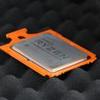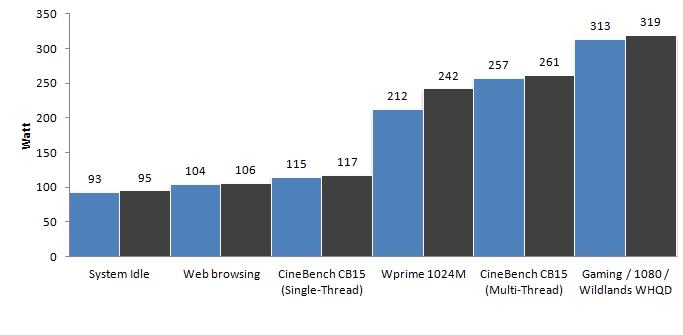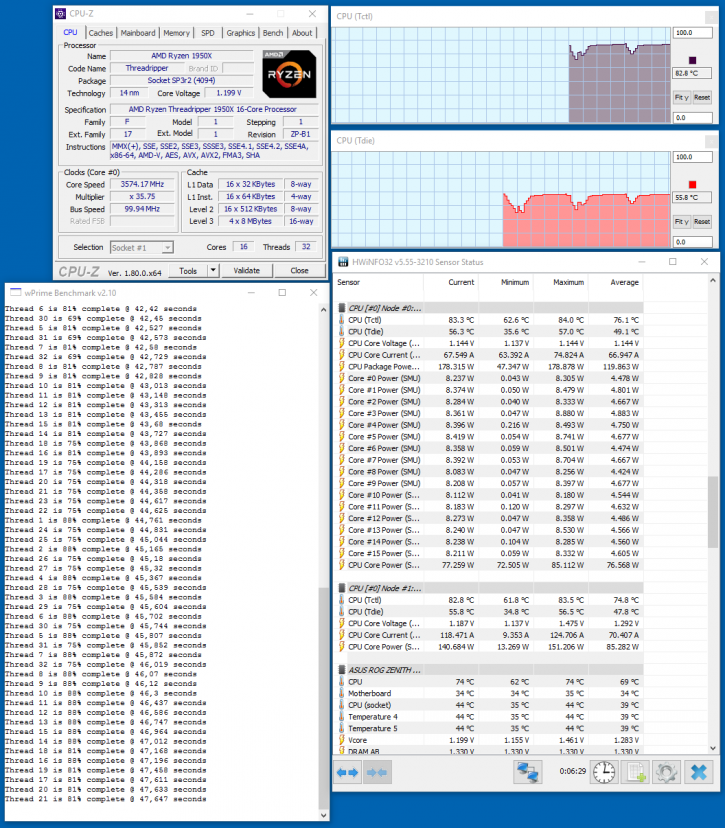Power Consumption & Temperatures
Power Consumption
In an IDLE state, a PC (motherboard / processor / GTX 1080 / memory / SSD) consumes roughly 90 Watts. This number depends and will vary per motherboard (added ICs / controllers / wifi / bluetooth) and PSU (efficiency). Keep in mind that we measure the ENTIRE PC, not just the processor's power consumption. Your average PC can differ from our numbers if you add optical drives, HDDs, soundcards etc.
* In blue, Threadripper 1920X and in black, Threadripper 1950X
As you can see, for a 16-core part the power consumption remains at very acceptable numbers. There is one thing we need to address though; Threadripper has two 8-core dies, effectively you could say that there are two processors active. And that does show in IDLE power consumption. Your average 4 or 8-core PC runs in the 50 Watt domain at idle, Threadripper sits just below 100 Watts, which is worthy of a mention alright.
I want to make it very clear that power consumption measurements will differ per PC and setup. Your attached components use power but your motherboard can also have additional ICs installed like an audio controller, 3rd party chips, network controllers, extra SATA controllers, extra USB controllers, and so on. These parts all consume power, so these results are a subjective indication. Next to that, we stress all CPU cores 100% and thus show peak power consumption. Unless you transcode video with the right software your average power consumption will be much lower.
We use the Corsair Hydro H105. Threadripper 1950X is being stressed with a couple of 1024M Prime runs. You can see a reported 83 Degrees C, for the die temperature you need to deduct and compensate by 27 Degrees C, which is 56 Degrees C, the true temperature. Below, you can read how that works.
Temperature Reporting
To keep a "consistent fan policy," AMD is forcing 20C offset on the Ryzen 1700X and 1800X processors. This makes them report temperature a good 20C above what the sensor reads. All models on the AM4 Platform have the same maximum tCTL value.
Threadripper has the same thing and has a 27 Degrees C offset. The primary temperature reporting sensor of the AMD Ryzen processor is a sensor called “T Control,” or tCTL for short. The tCTL sensor is derived from the junction (Tj) temperature—the interface point between the die and heatspreader—but it may be offset on certain CPU models so that all models on the AM4 Platform have the same maximum tCTL value. This approach ensures that all AMD Ryzen and thus Ryzen Threadripper processors have a consistent fan policy.
Specifically, the AMD Ryzen Threadripper uses a +27°C offset between the tCTL° (reported) temperature and the actual Tj° temperature. In the short term, users of the AMD Ryzen Threadripper can simply subtract 27°C to determine the true junction temperature of their processor.
| Product Name | True Junction Temp (Tdie) | tCTL Offset for Fan Policy | Temp Reported by (tCTL) |
|---|---|---|---|
| Threadripper 1950X | 43°C | 27°C | 70°C |
| Threadripper 1920X | 43°C | 27°C | 70°C |
| Ryzen 7 1800X | 38°C | 20°C | 58°C |
| Ryzen 7 1700X | 38°C | 20°C | 58°C |
| Ryzen 7 1700 | 38°C | 0°C | 38°C |



